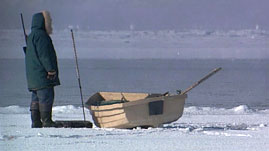Teachers' Domain - Digital Media for the Classroom and Professional Development
User: Preview

Source: National Film Board of Canada
In this video segment adapted from the National Film Board of Canada, learn how hunting is a fundamental part of the Inuit culture and how environmental changes are threatening the Inuit way of life. Observe hunters on the ice, and see how modern technology has found a place in traditional practices. Learn about the unpredictability of, and changes in, snow and ice conditions. Hear hunters describe some of the challenges they are facing, and explore how traditional knowledge can partner with Western science to address the changing environmental conditions.
Sea ice is an integral part of the Earth system. For instance, it helps to moderate global climate by reflecting solar radiation, and sea ice formation helps drives ocean circulation patterns. In the Arctic, sea ice also plays a major role in the ecosystems; ice algae and phytoplankton serve as the basis for the entire marine food web, and many animals (such as ice seals, walruses, and polar bears) rely on the ice for hunting, resting, feeding, and transportation.
The ice forms as ocean water loses energy to the surrounding air. When water near the ocean surface cools to its freezing point, it solidifies into sea ice that continues to grow during the winter. In the Arctic, sea ice reaches maximum extent (the area of ocean that it covers) around March and minimum extent in September. The thickness and extent of sea ice varies according to weather and climate. The condition of sea ice also depends on other factors, such as wind and ocean currents.
Sea ice that floats freely is known as pack, or drift, ice. Pack ice is not continuous; within pack ice, there are areas of open water, which provide access between the ocean and atmosphere for animals. Landfast (or fast) ice is sea ice that grows from the coast; it is anchored to the shore or to the ocean floor. Sea ice, and the snow that covers it, is an important resource for a variety of animals. For example, ringed seals construct birth lairs out of the snow cover on fast ice, walruses rest on ice edges and travel on ice floes—large pieces of pack ice—to new feeding areas, and polar bears use the ice as a hunting platform.
Over the past few decades, the extent of Arctic sea ice has been decreasing. While the extent of winter sea ice has decreased relatively slowly, summer sea ice has been declining at a dramatic rate—over 10 percent per decade. In addition, the average thickness of the ice has declined and there has been a trend toward later freezing and earlier breakup of sea ice. Changes in the sea ice impacts the behavior, health, and reproductive success of the animals that depend on it. For example, a longer open-water season means a longer period of fasting for polar bears, which is detrimental to their health. Lack of ice in the spring could also lead to a higher death rate for newborn seal pups that need to stay on the ice to access food and for protection against predators. Subsistence hunters are faced with the challenge of finding ways to adapt to changes in the range and availability of their prey, along with unstable and unpredictable ice conditions that make hunting hazardous.
 Loading Standards
Loading Standards Teachers' Domain is proud to be a Pathways portal to the National Science Digital Library.
Teachers' Domain is proud to be a Pathways portal to the National Science Digital Library.
